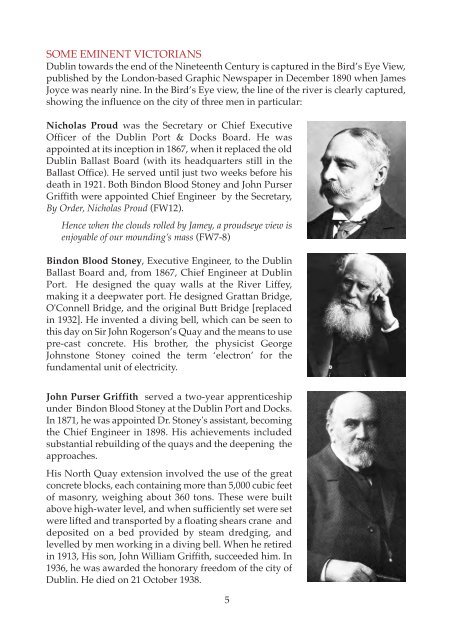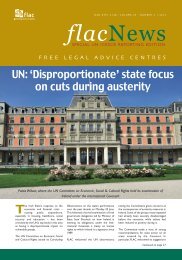FW75 Programme 2014
Programme of the Finnegans Wake 75 years exhibition in the Phoenix Park, Dublin
Programme of the Finnegans Wake 75 years exhibition in the Phoenix Park, Dublin
Create successful ePaper yourself
Turn your PDF publications into a flip-book with our unique Google optimized e-Paper software.
SOME EMINENT VICTORIANS<br />
Dublin towards the end of the Nineteenth Century is captured in the Bird’s Eye View,<br />
published by the London-based Graphic Newspaper in December 1890 when James<br />
Joyce was nearly nine. In the Bird’s Eye view, the line of the river is clearly captured,<br />
showing the influence on the city of three men in particular:<br />
Nicholas Proud was the Secretary or Chief Executive<br />
Officer of the Dublin Port & Docks Board. He was<br />
appointed at its inception in 1867, when it replaced the old<br />
Dublin Ballast Board (with its headquarters still in the<br />
Ballast Office). He served until just two weeks before his<br />
death in 1921. Both Bindon Blood Stoney and John Purser<br />
Griffith were appointed Chief Engineer by the Secretary,<br />
By Order, Nicholas Proud (FW12).<br />
Hence when the clouds rolled by Jamey, a proudseye view is<br />
enjoyable of our mounding’s mass (FW7-8)<br />
Bindon Blood Stoney, Executive Engineer, to the Dublin<br />
Ballast Board and, from 1867, Chief Engineer at Dublin<br />
Port. He designed the quay walls at the River Liffey,<br />
making it a deepwater port. He designed Grattan Bridge,<br />
O'Connell Bridge, and the original Butt Bridge [replaced<br />
in 1932]. He invented a diving bell, which can be seen to<br />
this day on Sir John Rogerson’s Quay and the means to use<br />
pre-cast concrete. His brother, the physicist George<br />
Johnstone Stoney coined the term ‘electron’ for the<br />
fundamental unit of electricity.<br />
John Purser Griffith served a two-year apprenticeship<br />
under Bindon Blood Stoney at the Dublin Port and Docks.<br />
In 1871, he was appointed Dr. Stoney's assistant, becoming<br />
the Chief Engineer in 1898. His achievements included<br />
substantial rebuilding of the quays and the deepening the<br />
approaches.<br />
His North Quay extension involved the use of the great<br />
concrete blocks, each containing more than 5,000 cubic feet<br />
of masonry, weighing about 360 tons. These were built<br />
above high-water level, and when sufficiently set were set<br />
were lifted and transported by a floating shears crane and<br />
deposited on a bed provided by steam dredging, and<br />
levelled by men working in a diving bell. When he retired<br />
in 1913, His son, John William Griffith, succeeded him. In<br />
1936, he was awarded the honorary freedom of the city of<br />
Dublin. He died on 21 October 1938.<br />
5





